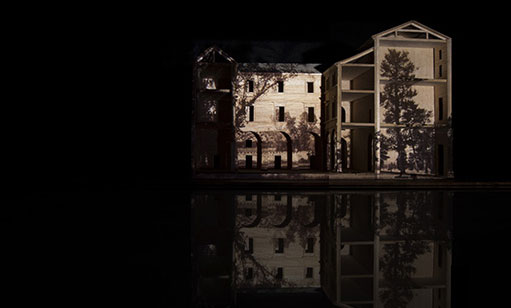In Mary Tsiongas’ “Mountain Park” a house surfaces from the flat blackness of night that surrounds it. The shadows of trees climb to its pitched roof, reach their viny arms through the windows, then fade again into the dark sky. Eerily devoid of human presence—not nightmarish, just suggestive—the black lake that reflects the scene reiterates the photograph’s meditative blankness. “The more I look at the work,” Tsiongas described of this series of photographs, which will make their debut at Richard Levy Gallery on May 27, “it begins to bring me back to ideas of grief and loss. … There’s something about them that because they’re so enveloped in darkness, and they’re reflected in this pool, they almost seem like tombs or monuments, there’s something lonely about them because there’s nothing else there. They each seem like the last building standing.”When I sat down with Tsiongas on a rainy afternoon, I thought I knew the substance of her most recent work—and in a sense, I did. What I saw were giant, nondescript buildings, frames emptied of windows, rooms never occupied, the walls strikingly white. In actuality, the origins of these photographs came from the now-defunct slide library of UNM’s art department. Tsiongas works as a professor at UNM, where she came across the abandoned scaled-down models of buildings, which she found interesting and decided to keep. Later, as the little-used collection of art slides was being disbanded, she scavenged a plethora of those, as well. What happened next is what Tsiongas described as a “playful experiment.” She had intended to project the slides onto the buildings and photograph them to later incorporate into the medium she usually works in, that is, film. Yet, as she began snapping pictures, she realized how “provocative and mysterious” they were. And so, she became “much more interested in them as photographs,” Tsiongas explained.Tsiongas sort of expects viewers to not quite be able to place these images. Where are these buildings? Why are they so devoid of humans? What scale do they exist on? “That’s why I call them aporia,” she said, “a greek word that means a kind of puzzle.” And Tsiongas expects what viewers will see in this body of work to be appropriately varied. As for Tsiongas herself, she sees “some of the elements that I’m always interested in—environmental concerns, the way we relate to landscape, where we live … and how we experience the landscape.” Going on, she wondered aloud, “I thought it was interesting that the building kind of consumed the landscape, but at the same time, in some of the imagery, it looks like the landscape is returning and consuming the building. I like that back and forth that it has.”In part, these scenes are difficult to situate because of their sharp contrasts and the consummate presence of darkness. (Tsiongas laughed about many of the photos being seven-eighths black.) As Tsiongas mentioned, to some the pictures may conjure fittingly dark visions of tombs and mausoleums, but importantly, running parallel to those notions are ideas of loss. To the artist, this equates to the loss of nature. And, poetically, in that loss of nature, the loss of home. Tsiongas recently returned from a residency in Wyoming, where she worked on the pieces. “Before I went there, I was thinking about these images as sort of dreamscapes or nightscapes, but with no stars in the sky,” she said. While reading up on light pollution, she discovered that it may soon be impossible to experience true earthly nighttime darkness anymore. Glimpsing “the closest thing to a really dark night that I had seen in a long time,” that loss felt compounded. Engulfing these pieces there is “a black that is impossible to see now.”Yet, bisecting the darkness of Tsiongas’ work is a beam of light from an obsolete machine that allows nature to take its stand in the frame. There’s vibrancy in these scenes, too, and a multitude of conceptual takes that surface from them. These ideas have revealed themselves in the process of creation to Tsiongas. “I’ve always been interested in beauty and mystery,” she said of her inquiry. “And so, I’ve always wanted to create imagery that lingers.” In these photographs, it is the questions accompanying them that make Tsiongas so successful in doing just that.
Repurpose/Revision/ReconstructionWorks by Bruce Warren Davis & Mary TsiongasOpening reception May 276-8pmRichard Levy Gallery514 Central SW










